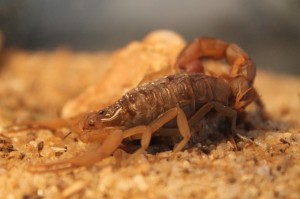News
Deadly Indian Red Scorpion entered Lanka with IPKF: Study
View(s):By L.B. Senaratne
A deadly new species of scorpion which has led to a number of deaths in the Jaffna district has been identified as “ Hottentotta Tumulus “in the family of ‘Buthidae’.
A species commonly known in India as the “Indian Red Scorpion”.
Researchers believe the deadly species was brought into the country during the period of the IPKF at the time they were in the country and the transport of goods from India into Sri Lanka. Researchers are of the view that these deadly scorpions would have come in goods in bulk .
They have ruled out the possibility of the species being introduced into the country by the LTTE.
Attention was drawn to this new variety of scorpions when a number of persons in the Jaffna District died of its sting.
Records maintained by Dr. Sivanasuthan of the Teaching Hospital in Jaffna and the treatment of a number of patients stung by this vicious scorpion revealed several deaths.

The deadly scorpion
According to his records 12 children died of the scorpion sting in 2003. Thereafter one death a year of scorpion stings was recorded in 2006, 2007 and 2009.
Statistics maintained by him indicate eighty deaths between January 2012 and February 2013. Of these, fifty-two percent were among females and while forty-two percent were male. Thirty percent of the deaths occurred among children between the ages of three and twelve.
Concerned with the growing numbers affected by scorpion stings, Dr. Sivanasuthan commenced collecting clinical specimens and epidemiological data of scorpion stings and worked in collaboration with Professor Sam Kularatne of the Faculty of Medicine at the University of Peradeniya.
However as there was no proper determination of the species –despite its venomous attacks and the way in which it moved –a tractor-like movement– specimens were forwarded to the Department of Zoology of the University of Peradeniya for identification.
Five live and three dead specimens of the “White Scorpions” from Pallai, Achchuveli and Karainagar which differed from the common Sri Lankan black scorpion were handed over to Professor Kithsiri Ranawana of the Department the Zoology of the University of Peradeniya and taken to the wildlife laboratory of the department for identification.
Preliminary investigations revealed the specimens collected from the Jaffna District possessed 31 pectinal teeth, while the Sri Lankan variety did not possess more than 25.
The external anatomical features led researchers Professor Ranawana and his research assistant Ironie Nagasena to recognize that similarities existed to the species ‘Hottenotta tumulus’ in India as described by scientist F. Kovarik in 2007. They also recognized the species were a recent introduction to the country.
As no museum specimens of this species was available in Sri Lanka the researchers were forced to seek outside assistance, and specimens were sent to consultant Frantisek Kovarik in the Czech Republic who confirmed the species as “ Hottentotta Tumulus “in the family of ‘Buthidae’.
The species commonly known in India as the “Indian Red Scorpion, would be the sixteenth species of scorpion found in Sri Lanka according to the researchers.
A study on the species was recently published in an occasional publication titled “Euscorpius” in March 2013. Among the researchers involved were Professor Kithsiri B.Ranawana, Dr. Nandana P. Dinamithra , Dr. Sivapalan Sivanasimtjan, Ironie I. Nagasena, Frantilek Kovarik and Professor Sam Kularatne.
With the identification of the species complete, the specimens, especially the females are to be handed over to Professor Sam Kularatne for the further investigation.
Presently there are 28 young specimens which will be preserved.
Follow @timesonlinelk
comments powered by Disqus


















